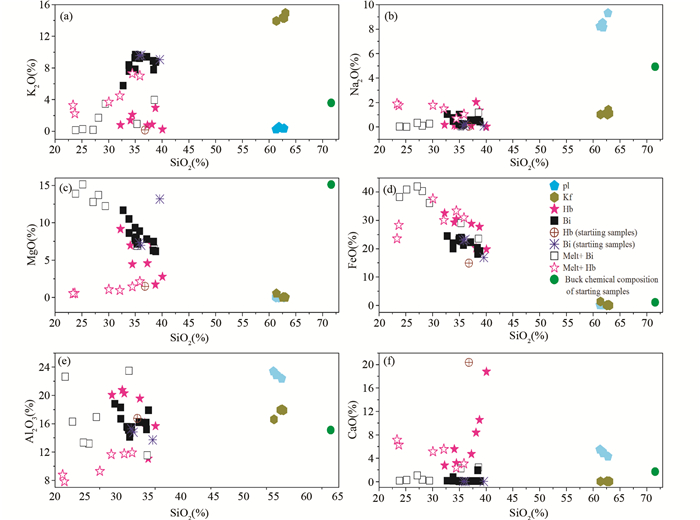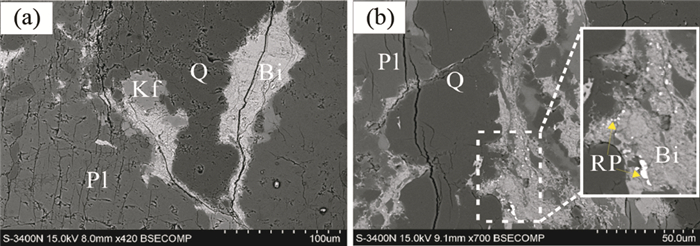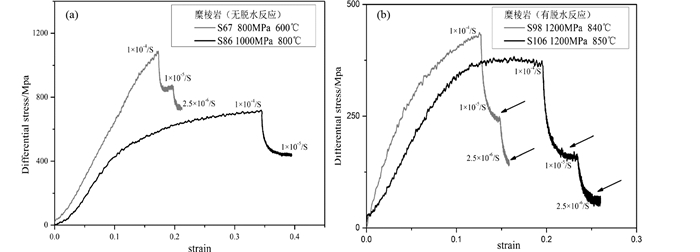2. 中国科学院大学地球科学学院, 中国科学院计算动力学重点实验室, 北京 100049;
3. 中国地震局地质研究所, 地震动力学国家重点实验室, 北京 100029
2. CAS Key Laboratory of Computational Geodynamics, University of Chinese Academy of Sciences, Beijing 100049, China;
3. State Key Laboratory of Earthquake Dynamics, Institute of Geology, China Earthquake Administration, Beijing 100029, China
众多野外和实验研究表明,岩石应变局部化通常伴有变质反应发生,而且变质反应和变形之间存在相互促进作用(Mitra,1978; Rutter and Brodie,1988; Austrheim and Boundy,1994; Wintsch et al.,1995; Stünitz and Tullis,2001; Keller et al.,2004; de Ronde et al.,2004,2005; Whitmeyer and Wintsch,2005; Holyoke and Tullis,2006a,b,c; Terry and Heidelbach,2006)。在脆性变形域,由于断层带内矿物粒度减小,以及存在大量裂缝,流体与岩石反应局限在断层带内,引起断层带应变弱化(Mitra,1978; Rutter and Brodie,1988; Austrheim and Boundy,1994; Wintsch et al.,1995; Wintsch and Yi,2002; Wintsch and Yeh,2013; Whitmeyer and Wintsch,2005; Holyoke and Tullis,2006c)。在塑性变形域,变质反应和变形关系比较复杂,表现在矿物反应与变形局部化关系、矿物反应对岩石强度影响等方面。例如,有些研究认为局部化分布的变质反应引起应变局部化(Holyoke and Tullis,2006c),但也有研究显示变形局部化控制了变质反应的分布(Wintsch et al.,1995; Wintsch and Yi,2002; Wintsch and Yeh,2013; Whitmeyer and Wintsch,2005),变形引起的位错应变增加了变质反应速率,促进了变质反应的发生(Stünitz and Tullis,2001; de Ronde et al.,2004,2005);又如,大部分研究显示,变质反应引起岩石应变弱化,导致强度降低(Rutter and Brodie,1988; Wintsch et al.,1995; Stünitz and Tullis,2001; Keller et al.,2004; de Ronde et al.,2004,2005; Whitmeyer and Wintsch,2005; Holyoke and Tullis,2006c),但也有部分研究结果显示矿物反应引起应变强化,导致强度增加(Zhou et al.,2012; 周永胜,2013)。因此,在塑性变形域,变质反应为什么会局部化分布,变形局部化如何形成,变质反应与变形局部化的关系如何,目前依然不甚清楚(Holyoke and Tullis,2006c)。
为了探讨变质反应与变形的关系,本文在天然糜棱岩高温高压流变实验的基础上(刘贵等,2013; Liu et al.,2016),分析了实验变形样品中的矿物反应分布特征以及矿物反应引起的化学成分变化,讨论了矿物反应与变形的相互影响。
2 实验方法、条件与实验样品实验在地震动力学国家重点实验室的3GPa熔融盐固体介质三轴高温高压实验系统上完成,实验设备、装样、实验方法参见刘贵等(2013)和Liu et al.(2016)。实验围压800~1200MPa,温度为600~890℃,应变速率1×10-4s-1,1×10-5s-1和2.5×10-6s-1,差应力300~1000MPa。变形实验采用等应变速率加载。
实验样品为采自华北克拉通北部的辽东金州拆离断层带上的糜棱岩。辽东地区是华北克拉通晚中生代破坏最为强烈和典型的地区。在晚中生代时期,伸展作用异常强烈。尤其是金州拆离断层带延伸约150km,是辽南变质核杂岩的主要组成部分,拆离断层带的位移使得下盘中部地壳岩石剥露地表。拆离断层带内表现为不同阶段递进演化的断层构造与构造岩组合,其中较新的脆性拆离断层面位于主拆离断层带的顶部,下伏为拆离断层带深部演化形成的糜棱岩带。主拆离断层带中,发育了一套完整的中上地壳断层构造岩序列,包括糜棱片麻岩、糜棱岩,角砾糜棱岩、微角砾岩和断层泥、假玄武玻璃(Liu et al.,2011)。本文中的糜棱岩样品,块状结构,面理显著,面理主要由线状排列的细长鳞片状黑云母和角闪石以及与此平行的石英集合体条带构成(图 1a,b)。
 |
图 1 糜棱岩原岩的微观结构特征
(a、b)扫描电镜下确定岩石中的各矿物,(b)是(a)中白色方框的放大部分,黑云母条带中镶嵌有角闪石和绿泥石;(c、d)岩石的显微结构,红色箭头代表钻取样品的方向,两个图中的右上角的照片是原岩面理方向(S0). Q-石英;Bi-黑云母;Pl-斜长石;Kf-钾长石;Ch-绿泥石;Hb-角闪石 Fig. 1 Microstructures of the starting mylonite samples (a, b) the mineral phases identified under SEM in starting samples, chlorite and hornblende inlaid in biotite bands. Fig.1b is the magnified area in the white square in Fig.1a; (c, d) the red arrows show drilling direction of the cylinder samples, the small images at the right corner of photos are the macro-image of starting samples, the red lines display the foliation S0. Q-quartz; Bi-biotite; Pl-plagioclase; Kf-K-feldspar; Ch-chlorite; Hb-hornblende |
糜棱岩样品的主要矿物组成:斜长石(30%~38%)、钾长石(15%~20%)、石英(25%~30%)、黑云母(10%~12%),其中黑云母条带中伴有角闪石和绿泥石。实验样品中的矿物粒度分为两个级别,大颗粒以斜长石和钾长石为主,粒度范围50~300μm,小颗粒以石英(10~35μm)、黑云母(8~40μm)、角闪石(3~8μm)、绿泥石为主(2~10μm)。
实验样品分为两组,分别在天然糜棱岩上沿平行和垂直面理的方向钻取圆柱状样品(图 1c,d的红色箭头方向),作为压缩方向垂直于面理方向和平行于面理方向的两组实验样品。圆柱状样品抛光磨圆至直径3mm,高度6mm的小圆柱形样品,放入烘箱内,在150℃条件下干燥48h,以脱去样品吸附的自由水。实验的主要力学参数见表 1。
| 表 1 糜棱岩的实验条件与力学参数 Table 1 Experimental conditions and mechanical data of granitic mylonite samples |
实验变形的糜棱岩样品微观结构研究表明,在实验变形过程中,应变局部化现象非常显著。其中,压缩方向垂直面理的样品,实验中形成了新的局部化变形条带,把原有的面理破坏改造,置换为新的面理;而压缩方向平行面理的样品,在实验变形过程中新的局部化变形带主体继承了原有面理(刘贵等,2013; Liu et al.,2016)。
实验变形后的糜棱岩样品在温度800~890℃时,角闪石和黑云母出现脱水反应,并伴有局部熔融。脱水反应产物主要出现在黑云母、角闪石条带边缘,而石英和长石之间没有出现矿物反应与熔体。显然,实验中出现的脱水反应主要受局部化分布的黑云母和角闪石控制,而沿面理分布的黑云母和角闪石条带是应变局部化的产物。因此,本实验中,矿物脱水反应主要受应变局部化控制。
在800℃时,黑云母和角闪石条带中出现大量细板柱状的角闪石微晶集合体(图 2a,b),黑云母边缘因脱水反应而出现暗化现象。840~850℃时,黑云母、细粒角闪石和绿泥石镶嵌在一起,因剪切变形而拉长,形成条带状,局部因变形而弯曲(图 2c-f)。在黑云母和角闪石条带中或其边缘分布有针状、团块状、细板柱状角闪石微晶,局部含有熔体(图 2c,e,f)。在890℃时,黑云母条带完全脱水暗化,强烈拉长形成细长条带,边缘出现部分熔融,脱水反应产物呈弥散状分布,局部出现针状的黑云母微晶(图 2g,h)。
 |
图 2 实验变形样品中黑云母与角闪石脱水反应和熔体的分布特征(扫描电镜照片)
图中红色箭头为实验压缩方向.(a、b)角闪石条带中的细板柱状角闪石微晶,边缘为包裹角闪石雏晶的熔体边;(c-f)黑云母、角闪石、绿泥石镶嵌分布,剪切拉长形成条带; 云母条带中细粒石英集合体及针柱状角闪石雏晶和团块状角闪石;(g、h)黑云母条带中的片状角闪石和带状绿泥石,针柱状的黑云母微晶,局部含熔融 Fig. 2 The dehydration reaction of biotite and hornblende in deformed samples and distribution of melt under scanning electron microscopy (SEM) The red arrows display the compression direction. (a, b) microcrystallites of hornblende occurred in the hornblende bands accompanied with melt rim around dehydrated hornblende; (c-f) biotite, hornblende and chlorite are sheared and enlonged; fine-grained quartz aggregates, needle cylindrical microcrystallites of hornblende and crumbed hornblende were found in biotite bands; (g, h) hornblende, chlorite and needle cylindrical microcrystallites of biotite are found in biotite bands with partial melting |
为了研究实验变形样品的脱水反应与熔体成分特征,对实验样品原岩和实验变形样品中主要矿物、脱水反应产物以及熔体进行电子探针分析。探针分析在核工业北京地质研究所JXA-8100电子探针分析仪完成,加速电压为15kV,电子束斑直径为5μm。分析结果见表 2。主要矿物、反应产物和熔体成分中各氧化物与SiO2关系图(图 3)显示,实验变形前后,斜长石的成分没有变化,钾长石的SiO2含量比原岩中钾长石的SiO2含量偏低,实验变形样品中的黑云母和角闪石成分中的FeO、CaO、MgO发生了变化,但成分变化最大的是黑云母和角闪石边缘的熔体。由于熔体分布非常局限,电子探针分析数据包含了熔体和其周围的微晶角闪石或黑云母。这些熔体和微晶矿物成分是黑云母和角闪石脱水反应最主要的产物。
| 表 2 实验样品矿物和熔体的探针分析数据(wt%) Table 2 Electron microprobe analyses date of the minerals and the melt of the deformed samples (wt%) |
 |
图 3 实验变形样品中主要矿物化学成分以及熔体和微晶成分
Pl-斜长石;Kf-钾长石;Hb-角闪石;Melt+Bi-熔体与黑云母微晶;Melt+Hb-熔体与角闪石微晶;Bi-黑云母;Hb(starting samples)-原岩中的角闪石;Bi(starting samples)-原岩中的黑云母;Buck chemical composition of starting samples-原岩全岩成分 Fig. 3 Chemical composition of mineral, melt and microcrystalline in deformed samples Pl-plagioclase; Kf-K-feldspar; Hb-Hornblende; Melt+Bi-Melt and microcrystallites of biotite; Melt+Hb-Melt and microcrystallites of hornblende; Bi-biotite; Hb (starting samples)-Hb in the starting samples; Bi (starting samples)-Bi in the starting samples |
化学成分显示,接近角闪石边缘的熔体与微晶(紫色空心五角星),SiO2的含量约为22%~38%,黑云母边缘的熔体与微晶(黑色空心正方形)SiO2的含量约为22%~35%,不仅与全岩分析中的SiO2含量(71%)相比少了很多,而且比原岩中的黑云母和角闪石中的SiO2含量(35%~39%)也低。脱水反应产物中SiO2含量普遍比较低,说明石英没有参与矿物反应与熔融,熔体成分具有超基性岩浆特征。角闪石边缘熔体与微晶中的MgO、Al2O3和CaO含量要低于角闪石,而K2O、Na2O和FeO含量要稍高于角闪石(图 3a-f),显示角闪石脱水熔融过程中的K2O、Na2O和FeO优先流入流体相的结果,这表明钾长石没有参与矿物反应和熔融。黑云母边缘的熔体与微晶中MgO和FeO含量都高于黑云母,而Al2O3、CaO含量稍高于黑云母,而K2O的含量比黑云母要低(图 3a-f)。
因此,实验变形中的矿物反应和部分熔融主要受黑云母和角闪石脱水熔融控制,反应形成的微晶和熔体主要出现在黑云母和角闪石边缘。微晶和熔体的成分特征表明,黑云母周围的反应产物和熔体主要来自于黑云母的脱水,角闪石边缘的反应产物和熔体来自于角闪石脱水,而钾长石没有参与反应与熔融。
本文中,部分熔融主要受黑云母和角闪石脱水熔融控制,熔体主要出现在黑云母和角闪石边缘。因此熔体的分布以局部团块状、环状为主,没有出现典型的三角形管状或薄膜状。这种脱水熔融与基性岩流变中出现的熔体分布有很大差别(Zhou et al.,2012)。
实验样品中,黑云母和角闪石的含量有限(糜棱岩中的角闪石和黑云母的总含量约10%~12%),熔体的含量普遍比较低,分布也比较局限。当熔体的含量在2%~3%时,熔体对岩石强度的影响很微弱;只有熔体含量超过3%时,熔体对岩石强度的弱化作用才开始显现(周永胜等,2003,2008)。而本文中的熔体含量是低于3%。
3.3 实验变形样品的矿物稳定性与脱水反应类型微观结构与成分分析表明,所有脱水反应产物和熔体中的SiO2含量显著低于原岩全岩成分中的SiO2,说明石英没有参与矿物反应。实验样品中的斜长石,在整个实验变形过程中都存在,而且实验前后斜长石的矿物成分变化不大,属于稳定性矿物,基本没有参与实验过程中的矿物反应。角闪石和黑云母由于在实验变形过程中发生了脱水反应,其矿物化学成分变化较大。因此,在变形过程中斜长石、钾长石和石英是相对稳定的矿物,而角闪石和黑云母出现了显著的成分变化,是矿物反应的主要贡献者。根据上述成分变化,可以确定实验变形过程中出现的脱水反应方程式。
黑云母和角闪石脱水反应方程式为:
Bi1+Hb1→Bi2+Hb2+Melt+water
Holyoke and Tullis(2006c)研究了黑云斜长片麻岩在剪切变形实验中出现的脱水反应。在该实验中,脱水反应的分布同样受到变形引起的黑云母局部化条带控制,而且实验变形中出现的脱水反应也与本研究类似,以黑云母脱水反应为主。但由于Holyoke and Tullis(2006c)实验中,围压为1500~2000MPa,温度为750~800℃,因此,反应产物以新的黑云母为主,有少量微晶石榴石,实验过程中没有出现明显的部分熔融。其反应方程式为:
Bi1+Pl1+Kf1+Q→Gt+Bi2+Pl2+Kf2+water
本实验的围压800~1200MPa,没有达到石榴石的稳定压力范围,因此,没有发现石榴石。
4 讨论4.1 与静压条件下黑云母和角闪石脱水反应产物与熔体成分对比黑云母和角闪石脱水反应产物与部分熔融的熔体成分不仅与实验样品成分、温度、压力有关,而且与实验样品矿物分布、应变、部分熔融程度相关。
Patiño Douge and Beard(1995)采用粉末样品和细粒矿物晶体,合成黑云石英斜长片麻岩和角闪岩样品,在高温静高压实验条件下,研究了黑云母和角闪石的脱水反应与部分熔融成分。实验温度范围T=840~1000℃,压力范围P=300~1500MPa。实验结果表明,黑云母脱水反应与部分熔融结果为:
在P<1000MPa时,黑云母+斜长石+石英+钛铁矿→斜长石+碱性长石+单斜辉石+磁铁矿+熔体+水;
在P>1000MPa时,黑云母+斜长石+石英+钛铁矿→斜长石+碱性长石+单斜辉石+石榴石+磁铁矿+金红石+熔体+水;
角闪石脱水反应与部分熔融结果为:
在P<1000MPa,T<950℃时,角闪石+斜长石+石英+钛铁矿→斜长石+单斜辉石+斜方辉石+磁铁矿+熔体+水;P>1000MPa,T>950℃时,角闪石+斜长石+石英+钛铁矿→斜长石+石榴石+单斜辉石+斜方辉石+磁铁矿+金红石+熔体+水。
显然,在该实验结果中,无论是黑云母还是角闪石,其脱水反应中都出现了辉石(中压)或石榴石(高压),这些脱水反应产物接近于基性岩。虽然在其实验初始样品中有2%的钛铁矿,但在实验后,钛铁矿转变成了磁铁矿与金红石,显然,辉石或石榴石的生成不是实验样品成分引起的。
本研究中,实验温度在800~890℃,压力在800~1200MPa,但实验结果中没有发现辉石或石榴石,反应产物仍然是微晶黑云母和角闪石与微量熔体。而Holyoke and Tullis(2006c)的实验围压为1500~2000MPa,温度为750~800℃,黑云母脱水反应产物以新的黑云母为主,有微晶石榴石,没有熔体。
为了与本研究中的熔体成分进行对比分析,我们对Patiño Douge and Beard(1995)实验中给出的熔体数据进行了重新分析(图 4)。熔体的化学成分(图 4)显示,黑云母脱水熔融形成的熔体(黑色空心圆圈)和角闪石脱水熔融形成的熔体(红色三角形)的SiO2含量基本大于70%,而实验前云母片麻岩和角闪岩全岩SiO2含量分别为63%和61%左右,表明石英参与了熔融,导致SiO2含量比原岩的含量高。熔体MgO和FeO含量比相对应的原岩MgO和FeO含量低,其中黑云母脱水熔体和角闪石脱水熔体的MgO、Na2O、Al2O3和FeO含量比较接近,而且随SiO2变化趋势基本一致(图 4b-e),而黑云母脱水熔体中K2O含量高于角闪石脱水熔体(图 4a),但CaO含量低于角闪石脱水熔体(图 4f)。这些成分显示,在实验过程中,岩石中的所有矿物基本都参加了熔融。
 |
图 4 黑云斜长片麻岩和角闪岩部分熔融的熔体成分及全岩化学成分(数据据Patiño Douge and Beard,1995) Dehydration-melting of biotite gneiss-黑云斜长片麻岩边缘的熔体;Dehydration-melting of amphibotite-角闪岩边缘的熔体;Biotite gneiss(starting)黑云斜长片麻岩原岩;Amphibolite(starting)-角闪岩原岩 Fig. 4 Chemical composition of the melt of dehydration-melting of biotite gneiss and amphibolite and buck chemical composition of starting samples(data from Patiño Douge and Beard,1995) |
Patiño Douge and Beard(1995)实验结果表明,脱水熔融形成的熔体成分接近于花岗质岩石成分,而其脱水反应产物接近于基性岩。显然,这种所有矿物都参与的熔融,在矿物反应以及部分熔融的熔体含量、分布和成分等方面都区别于本研究中的黑云母或角闪石脱水反应与熔融。
本研究和Holyoke and Tullis(2006c)的实验与Patiño Douge and Beard(1995)实验最大区别有三点:(1)前两者采用的是天然糜棱岩和片麻岩样品,黑云母和角闪石分布不均匀,而后者采用的是合成样品,黑云母和角闪石分布比较均匀;(2)前两者的实验为变形条件下的脱水反应,加剧了黑云母和角闪石的非均匀分布,而后者处于静压条件,实验样品结构相对稳定,矿物没有发生应变;(3)本实验中,熔体含量非常少,并且分布局限,Holyoke and Tullis(2006c)的实验中基本没有出现熔体,而Patiño Douge and Beard(1995)的实验中,部分熔融程度高,熔体含量大,实验中石英、黑云母、角闪石基本消失。因此,黑云母和角闪石的局部化分布和脱水程度低,可能是造成脱水反应产物差别巨大的原因。
4.2 矿物脱水反应对岩石变形机制的影响实验和野外变形岩石研究表明,变质反应引起应变弱化和局部化的原因有以下几方面(Holyoke and Tullis,2006c):(1)退变质反应生成含水的弱矿物相,例如花岗质岩石中的长石水解反应(Mitra,1978; Wintsch et al.,1995; Wintsch and Yi,2002; Wintsch and Yeh,2013; Whitmeyer and Wintsch,2005);(2)含水矿物的脱水反应,引起岩石局部化破裂(Raleigh and Paterson,1965; Murrell and Ismail,1976)或水引起岩石塑性弱化(周永胜等,2008);(3)反应生成细粒混合矿物相,导致变形机制由位错蠕变向颗粒边界滑移和扩散蠕变转化,引起应变弱化(Snow and Yund,1987; Rutter and Brodie,1988; Burnley and Green,1989; Stünitz and Tullis,2001; Schmidt et al.,2003; de Ronde et al.,2004; Holyoke and Tullis,2006b)和变形局部化(Brodie and Rutter,1985; Holyoke and Tullis,2006a);(4)反应引起的体积变化促进了超塑性变形(Dunand et al.,2001)。
在本研究中,黑云母和角闪石的脱水反应分布主要受应变局部化控制。在含脱水反应的应变局部化带内,我们发现了上述变质反应对变形机制影响四种情形中的两种,即由于矿物反应引起岩石局部化破裂、反应生成细粒混合矿物相这两种情况。
例如,在840℃条件下,虽然大部分黑云母和角闪石与石英都表现为塑性变形(刘贵等,2013; Liu et al.,2016),但局部发现黑云母脱水反应引起了岩石的局部化破裂(图 5a),破裂带一般沿黑云母和角闪石条带分布。在850℃条件下,在应变集中区,黑云母、角闪石和石英条带被剪切拉长,黑云母和角闪石发生脱水反应,形成弥散状分布的细粒矿物混合集合体,并且伴有部分熔融(图 5b)。
 |
图 5 脱水反应对变形机制影响(扫描电镜照片)
(a)样品S98,在局部化分布的黑云母和角闪石条带内,由于脱水反应,导致在塑性变形的变形带内出现破裂;(b)样品S106,在局部化的黑云母和角闪石被剪切拉长,脱水反应产物形成弥散状分布的细粒矿物混合集合体,并且伴有部分熔融. RP-矿物反应产物 Fig. 5 Dehydration reaction effect on the deformation mechanism (pictures of SEM) (a) in Sample S98, fractures caused by dehydration reaction occur in the localized distribution of biotite and hornblende bands; (b) in Sample S106, localized biotite and hornblende are stretched and elongated. Dehydration reaction production formed diffuse distribution of fine-grained mixture aggregates accompanied by partial melting. RP-reaction production |
实验研究表明,矿物反应生成的新矿物相抑制了矿物颗粒的增长并促进了细粒矿物的稳态,对稳态变形和岩石弱化具有显著的作用(Stünitz and Tullis,2001)。在本研究中,受变形局部化的影响,脱水反应仅分布于黑云母和角闪石条带的边缘。由于反应产物和熔体分布局限,对岩石变形的影响主要体现在局部化的剪切带内。由于脱水反应产物与相邻的细粒石英混合,在局部化的剪切带内,石英发生亚颗粒化,细粒黑云母和石英的变形机制由位错蠕变转变为扩散蠕变,引起岩石出现应变弱化。
例如,糜棱岩在600℃时,由于没有脱水反应与熔融,糜棱岩样品整体表现为应变强化到稳态蠕变的趋势(图 6a);在800℃条件下,脱水反应与熔融程度比较低,反应产物的影响微弱,糜棱岩样品整体表现为稳态蠕变(图 6a)。与此相反,在840~850℃时(样品S98和S106)的应力-应变曲线中,随着应变增加,样品从稳态蠕变(应力趋于恒定状态)逐渐转化为明显的应变弱化行为(应力随应变逐渐降低,图中箭头所示)(图 6b)。
 |
图 6 应力-应变曲线显示出的脱水反应引起应变弱化
(a)在低温条件下,糜棱岩表现出稳态蠕变特征,没有出现应变弱化;(b)糜棱岩样品出现的应变弱化(图中箭头所示) Fig. 6 The stress-strain curves show the strain weakening caused by dehydration reaction (a) at low temperature, the stress-strain curve of mylonite samples show steady creep. There is no strain weakening; (b) strain weakening occurred in deformed mylonite samples (indicated by the red arrows) |
因此,在本实验结果中,脱水反应对变形的影响主要体现为,脱水反应产生了细粒混合矿物相,使得在局部化的剪切带内变形机制从位错蠕变转变为扩散蠕变,导致样品出现应变弱化。另外脱水反应引起了局部破裂发生。
4.3 变形对矿物反应的影响实验和野外变形样品研究表明,变形能够影响变质反应的反应动力学(Brodie and Rutter,1985),体现在以下几方面(Holyoke and Tullis,2006c):(1)变形普遍产生细粒化(碎裂或动态重结晶作用),增加了矿物表面积,促进了新矿物相成核与反应接触面(Berger and Stünitz,1996; Handy and Stünitz,2002; Yonkee et al.,2003);(2)晶体塑性变形引起矿物位错密度增加,促进了晶体内部成核(Stünitz,1998)和矿物溶解(Wintsch and Dunning,1985);(3)差应力作用增加了局部的正应力,导致局部出现矿物反应边界向高应力方向迁移(Vaughan et al.,1984; Brodie,1995);(4)差应力作用增加了平均应力,导致局部出现矿物反应边界向高压力方向迁移,并且增加了反应速率(de Ronde et al.,2005);(5)晶体塑性变形引起局部剪切生热,导致矿物反应边界向高温方向迁移,并且增加了反应速率(Boullier and Gueguen,1975; Poirier,1980; White et al.,1980)。
本研究中的所有实验都在差应力条件下完成,在低温条件下(600~700℃),样品脆性破裂与局部塑性变形共存。在高温条件下(800~890℃),样品中黑云母和角闪石与石英强烈拉长形成条带,样品以塑性变形为主,并伴有黑云母和角闪石的脱水反应与熔融,局部含有破裂。显然,本研究中,黑云母和角闪石的脱水反应主要受实验温度控制,只有当温度达到黑云母和角闪石的脱水条件,才会发生脱水反应。但变形引起晶体塑性变形增加了位错密度和矿物细粒化、以及差应力作用增加了局部的正应力和平均应力等因素对脱水反应都具有一定影响。
在高温条件下,强烈的局部化剪切变形,一方面引起黑云母、角闪石和石英粒度减小,增加了矿物表面积,有利于脱水反应发生;另一方面,应变晶体塑性变形引起矿物位错密度增加,促进了晶体内部成核,黑云母与角闪石的脱水分解促进了黑云母和角闪石的脱水反应与微晶黑云母和角闪石的产生。Holyoke and Tullis(2006c)的实验表明,在高应变低应力条件下,样品中形成局部化的剪切带,随着应变增加,样品在局部化的剪切带内出现反应物。这表明高应变促进矿物反应,并有利于反应物的生成。其中,黑云母的扭折可能会促进动态重结晶过程中矿物成核形成新的黑云母(Etheridge and Honns,1974; Bell,1978; Holyoke and Tullis,2006b)。黑云母的扭折可能是矿物反应物最初的成核位置,一旦黑云母的动态重结晶开始,反应物的成核可能发生在不同的位置,不仅仅是在黑云母矿物的边缘。
另外,由于在差应力作用下,增加了局部的正应力和平均应力,增加了黑云母和角闪石能够稳定存在的压力范围,这可能是反应产物以微晶黑云母和角闪石为主,而没有转化为辉石的原因。
本研究结果与Holyoke and Tullis(2006c)的实验结果表明,由于变形引起黑云母和角闪石剪切拉长,形成局部化的剪切带。黑云母和角闪石的脱水反应主要发生在局部化剪切带内,高应变促进了脱水反应发生,而脱水反应引起了岩石的应变弱化,反过来促进了应变局部化。
5 结论本文在天然糜棱岩高温高压流变实验的基础上,分析了实验变形样品中的矿物反应分布特征以及矿物反应引起的化学成分变化,讨论了矿物反应与变形的相互影响。得到的主要结论有:
(1) 微观结构分析表明,实验变形后的糜棱岩样品在温度800~890℃时,角闪石和黑云母出现脱水反应,形成微晶角闪石和黑云母,并伴有局部熔融。受应变局部化控制,脱水反应产物主要出现在黑云母、角闪石条带边缘。
(2) 微晶和熔体的成分分析表明,脱水反应形成的微晶与熔体SiO2含量非常低,黑云母周围的反应产物和熔体主要来自于黑云母的脱水,角闪石边缘的反应产物和熔体也主要来自于角闪石脱水。石英、钾长石和斜长石没有参与反应与熔融。
(3) 脱水反应产生了细粒混合矿物相,使得在局部化的剪切带内变形机制从位错蠕变转变为扩散蠕变,导致样品出现应变弱化。另外脱水反应引起了局部脆性破裂。
(4) 变形引起晶体塑性变形增加了位错密度和矿物细粒化,促进了晶体内部成核和黑云母与角闪石的脱水分解;差应力作用增加了局部的正应力和平均应力,增加了黑云母和角闪石能够稳定存在的压力范围。
致谢 感谢审稿专家提出的建设性意见与建议,对提高论文质量有很大的帮助。| [1] | Austrheim H and Boundy TM. 1994. Pseudotachylytes generated during seismic faulting and eclogitization of the deep crust. Science, 265(5168): 82-83 |
| [2] | Bell TH. 1978. Syntectonic nucleation of new grains in deformed mica. Tectonophysics, 51(3-4): T31-T37 |
| [3] | Berger A and Stünitz H. 1996. Deformation mechanisms and reaction of hornblende: Examples from the Bergell tonalite (Central Alps). Tectonophysics, 257(2-4): 149-174 |
| [4] | Boullier AM and Gueguen Y. 1975. SP-mylonites: Origin of some mylonites by superplastic flow. Contributions to Mineralogy and Petrology, 50(2): 93-104 |
| [5] | Brodie KH and Rutter EH. 1985. On the relationship between deformation and metamorphism, with special reference to the behavior of basic rocks. In: Thompson AB and Rubie DC (eds.). Metamorphic Reactions: Kinetics, Textures, and Deformation. New York: Springer 4: 138-179 |
| [6] | Brodie KH. 1995. The development of orientated symplectites during deformation. Journal of Metamorphic Geology, 13(4): 499-508 |
| [7] | Burnley PC and Green HW. 1989. Stress dependence of the mechanism of the olivine-spinel transformation. Nature, 338(6218): 753-756 |
| [8] | de Ronde AA, Heilbronner R, Stünitz H and Tullis J. 2004. Spatial correlation of deformation and mineral reaction in experimentally deformed plagioclase-olivine aggregates. Tectonophysics, 389(1-2): 93-109 |
| [9] | de Ronde AA, Stünitz H, Tullis J and Heilbronner R. 2005. Reaction-induced weakening of plagioclase-olivine composites. Tectonophysics, 409(1-4): 85-106 |
| [10] | Dunand DC, Schuh C and Goldsby DL. 2001. Pressure-induced transformation plasticity of H2O ice. Physical Review Letters, 86(4): 668-671 |
| [11] | Etheridge MA and Hobbs BE. 1974. Chemical and deformational controls on recrystallization of mica. Contributions to Mineralogy and Petrology, 43(2): 111-124 |
| [12] | Handy MR and Stünitz H. 2002. Strain localization by fracturing and reaction weakening: A mechanism for initiating exhumation of subcontinental mantle beneath rifted margins. In: Meer S, Drury MR, de Bresser JHP and Pennock GM (eds.). Deformation Mechanisms, Rheology and Tectonics: Current Status and Future Perspectives. Geological Society, London, Special Publications, 200(1): 387-407 |
| [13] | Holyoke III CW and Tullis J. 2006a. Formation and maintenance of shear zones. Geology, 34(2): 105-108 |
| [14] | Holyoke III CW and Tullis J. 2006b. Mechanisms of weak phase interconnection and the effects of phase strength contrast on fabric development. Journal of Structural Geology, 28(4): 621-640 |
| [15] | Holyoke III CW and Tullis J. 2006c. The interaction between reaction and deformation: An experimental study using a biotite + plagioclase + quartz gneiss. Journal of Metamorphic Geology, 24(8): 743-76 |
| [16] | Keller LM, Abart R, Stünitz H and De Capitani C. 2004. Deformation, mass transfer and mineral reactions in an eclogite facies shear zone in a polymetamorphic metapelite (Monte Rosa Nappe, western Alps). Journal of Metamorphic Geology, 22(2): 97-118 |
| [17] | Liu G, Zhou YS, Yao WM, Liu JL, He CR and Zhang YY. 2013. Experimental study on the effect of pre-existing fabric to deformation of granitic gneiss under high temperature and pressure. Chinese Journal of Geophysics, 56(7): 2332-2347 (in Chinese with English abstract) |
| [18] | Liu G, Zhou YS, He CR, Yao WM, Liu JL and Zhang YY. 2016. An experimental study of effect of pre-existing fabric on deformation of foliated mylonite at high temperature and pressure. Geological Journal, 51(1): 92-112 |
| [19] | Liu JL, Ji M, Shen L, Guan HM and Davis GA. 2011. Early Cretaceous extensional structures in the Liaodong Peninsula: Structural associations, geochronological constraints and regional tectonic implications. Science China (Earth Sciences), 54(6): 823-842 |
| [20] | Mitra G. 1978. Ductile deformation zones and mylonites; the mechanical processes involved in the deformation of crystalline basement rocks. American Journal of Science, 278(8): 1057-1084 |
| [21] | Murrell SAF and Ismail IAH. 1976. The effect of decomposition of hydrous minerals on the mechanical properties of rocks at high pressures and temperatures. Tectonophysics, 31(3-4): 207-258 |
| [22] | Patiño Douce AE and Beard JS. 1995. Dehydration-melting of biotite gneiss and quartz amphibolite from 3 to 15kbar. Journal of Petrology, 36(3): 707-738 |
| [23] | Poirier JP. 1980. Shear localization and shear instability in materials in the ductile field. Journal of Structural Geology, 2(1-2): 135-142 |
| [24] | Raleigh CB and Paterson MS. 1965. Experimental deformation of serpentinite and its tectonic implications. Journal of Geophysical Research, 70(16): 3965-3985 |
| [25] | Rutter EH and Brodie KH. 1988. Experimental "sytectonic" dehydration of serpentinite under conditions of controlled pore water pressure. Journal of Geophysical Research, 93(B5): 4907-4932 |
| [26] | Schmidt C, Bruhn D and Wirth R. 2003. Experimental evidence of transformation plasticity in silicates: Minimum of creep strength in quartz. Earth and Planetary Science Letters, 205(3-4): 273-280 |
| [27] | Snow E and Yund RA. 1987. The effect of ductile deformation on the kinetics and mechanisms of the aragonite-calcite transformation. Journal of Metamorphic Geology, 5(2): 141-153 |
| [28] | Stünitz H. 1998. Syndeformational recrystallization: Dynamic or compositionally induced? Contributions to Mineralogy and Petrology, 131(2-3): 219-236 |
| [29] | Stünitz H and Tullis J. 2001. Weakening and strain localization produced by syn-deformational reaction of plagioclase. International Journal of Earth Sciences, 90(1): 136-148 |
| [30] | Terry MP and Heidelbach F. 2006. Deformation-enhanced metamorphic reactions and the rheology of high-pressure shear zones, Western Gneiss Region, Norway. Journal of Metamorphic Geology, 24(1): 3-18 |
| [31] | Vaughan PJ, Greeen HW and Coe RS. 1984. Anisotropic growth in the olivine-spinel transformation of Mg2GeO4 under nonhydrostatic stress. Tectonophysics, 108(3-4): 299-322 |
| [32] | White SH, Burrows SE, Carreras J, Shaw ND and Humphreys FJ. 1980. On mylonites in ductile shear zones. Journal of Structural Geology, 2(1-2): 175-187 |
| [33] | Whitmeyer SJ and Wintsch RP. 2005. Reaction localization and softening of texturally hardened mylonites in a reactivated fault zone, central Argentina. Journal of Metamorphic Geology, 23(6): 411-424 |
| [34] | Wintsch RP and Dunning J. 1985. The effect of dislocation density on the aqueous solubility of quartz and some geologic implications: A theoretical approach. Journal of Geophysical Research, 90(B5): 3649-3657 |
| [35] | Wintsch RP, Christoffersen R and Kronenberg AK. 1995. Fluid-rock reaction weakening of fault zones. Journal of Geophysical Research, 100(B7): 13021-13032 |
| [36] | Wintsch RP and Yi K. 2002. Dissolution and replacement creep: A significant deformation mechanism in mid-crustal rocks. Journal of Structural Geology, 24(6-7): 1179-1193 |
| [37] | Wintsch RP and Yeh MW. 2013. Oscillating brittle and viscous behavior through the earthquake cycle in the Red River Shear Zone: Monitoring flips between reaction and textural softening and hardening. Tectonophysics, 587(2): 46-62 |
| [38] | Yonkee WA, Parry WT and Bruhn RL. 2003. Relations between progressive deformation and fluid-rock interaction during shear-zone growth in a basement-cored thrust sheet, Sevier orogenic belt, Utah. American Journal of Science, 303(1): 1-59 |
| [39] | Zhou YS, He CR, Sang ZN and Jin ZM. 2003. Melt characters of partial melted gabbro under plastic deformation condition. Chinese Journal of Geophysics, 46(4): 482-487 (in Chinese with English abstract) |
| [40] | Zhou YS, He CR and Li HJ. 2008. The effect of melt distribution on the rheology of rocks. Earth Science Frontiers, 15(3): 273-278 (in Chinese with English abstract) |
| [41] | Zhou YS, Rybacki E, Wirth R, He CR and Dresen G. 2012. Creep of partially molten fine-grained gabbro under dry condition. Journal of Geophysical Research, 117(B5): B05204 |
| [42] | Zhou YS. 2013. Rheological complexity of continental lower crust based on creep tests of mafic rocks. Seismology and Geology, 35(2): 328-346 (in Chinese with English abstract) |
| [43] | 刘贵, 周永胜, 姚文明, 刘俊来, 何昌荣, 张媛媛. 2013. 组构对花岗片麻岩高温流变影响的实验研究. 地球物理学报, 56(7): 2332-2347 |
| [44] | 周永胜, 何昌荣, 桑祖南, 金振民. 2003. 在塑性变形过程中辉长岩部分熔融的熔体特征. 地球物理学报, 46(4): 482-487 |
| [45] | 周永胜, 何昌荣, 李海军. 2008. 熔体的形态与分布特征对岩石流变的影响. 地学前缘, 15(3): 273-278 |
| [46] | 周永胜. 2013. 基性岩流变实验揭示出大陆下地壳流变的复杂性. 地震地质, 35(2): 328-346 |
 2016, Vol. 32
2016, Vol. 32


